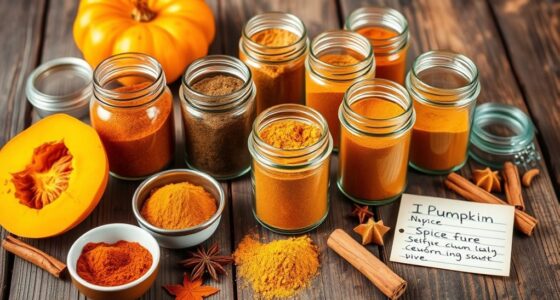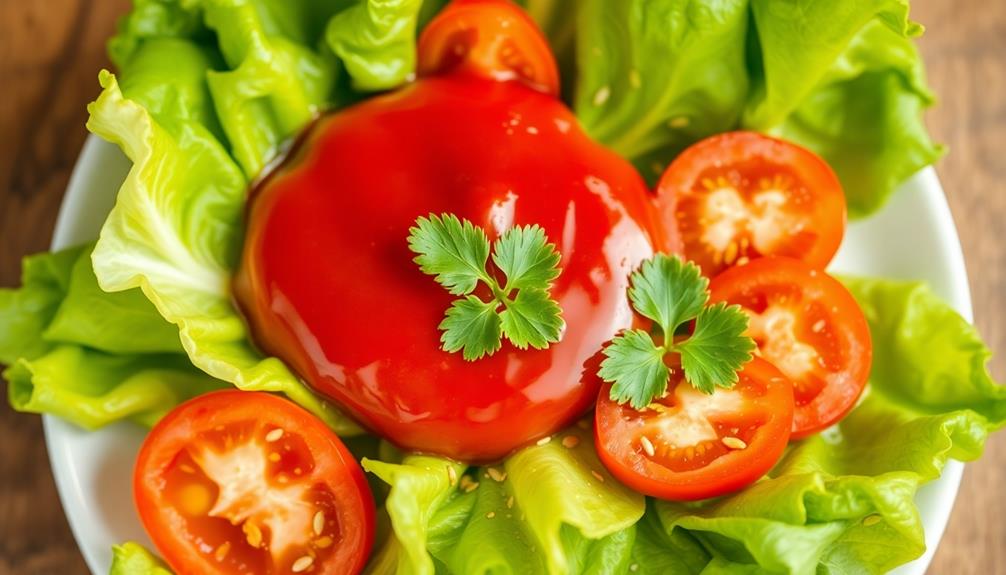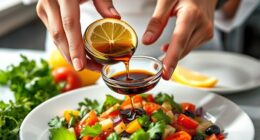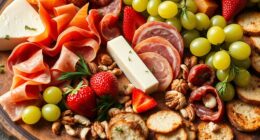Quick-pickling works by rapidly lowering the vegetable’s pH with vinegar or acidic brines, which instantly halts microbial activity and preserves crispness. This process involves acidifying the produce to a safe level (pH 4.6 or lower), causing vegetable cell walls to tighten and maintain texture. Unlike traditional fermentation, which takes weeks and relies on bacteria, quick-pickling achieves crunch and flavor through immediate acidification—if you explore further, you’ll discover the science behind every crisp bite.
Key Takeaways
- Quick-pickling uses rapid acidification with vinegar to lower pH and preserve vegetable crunch without microbial fermentation.
- Acidic environments cause vegetable cell walls to tighten, maintaining crispness during storage.
- Achieving a pH of 4.6 or lower ensures safety and inhibits spoilage bacteria.
- The process bypasses osmotic dehydration and microbial fermentation, relying instead on immediate pH control.
- Proper acid levels enhance flavor, color, and texture, ensuring vibrant, crunchy preserved vegetables.

Ever wondered how you can turn vegetables into tangy, crunchy pickles in just a fraction of the time it takes traditional methods? The secret lies in understanding the science behind quick-pickling, especially the fermentation chemistry and pH balance involved. Unlike slow fermentation that relies on natural microbial activity over weeks, quick-pickling uses vinegar or acidic brines to create a hostile environment for spoilage bacteria almost instantly. This rapid acidification is key to achieving that crisp texture and vibrant flavor in a matter of hours.
Quick-pickling uses vinegar to rapidly lower pH, preserving crispness and flavor in hours.
When you start quick-pickling, you’re essentially controlling the pH balance of your vegetables. By adding vinegar, which is acetic acid, you lower the pH rapidly, creating an environment unsuitable for harmful bacteria. This acidic environment not only preserves your vegetables but also influences their texture. The lower pH causes the vegetable cell walls to tighten, helping them stay crisp longer. This process is a stark contrast to fermentation chemistry in traditional pickling, where lactic acid bacteria gradually produce acid as they ferment sugars, lowering the pH over days or weeks.
In quick-pickling, the role of vinegar is straightforward: it acidifies the solution immediately, stopping spoilage bacteria from growing. This is why your pickles remain crunchy and flavorful for longer periods without the need for lengthy fermentation. The pH balance is vital here; ideally, you want your pickling solution to reach a pH of 4.6 or lower to guarantee safety and stability. You can test this with pH strips to confirm that your pickles are in the safe zone, preventing any unwanted microbial activity.
Understanding fermentation chemistry helps you appreciate why quick-pickles stay crisp. In traditional fermentation, the microbial activity creates a gradual build-up of acids, which can sometimes lead to softer textures if not carefully managed. In quick-pickling, by directly adding vinegar and controlling the pH, you bypass this microbial process altogether, locking in that satisfying crunch. The acidity also enhances flavors, making your quick-pickled vegetables tangy and bright without the wait.
In essence, quick-pickling is all about manipulating the chemistry of acidity and pH balance to preserve vegetables efficiently. You accelerate the process by introducing an acid source that instantly lowers the pH, creating a safe, crisp, and flavorful product in a fraction of the time. Additionally, understanding the role of color accuracy in preservation methods can help you choose ingredients and techniques that maximize visual appeal and freshness once pickled. Once you grasp how fermentation chemistry and pH control work, you can experiment confidently, tailoring your pickling solutions for perfect crunch and zing every time.
Frequently Asked Questions
How Long Does Quick-Pickling Typically Preserve Vegetables?
Quick-pickling typically preserves vegetables for about 1 to 4 weeks, depending on fermentation duration and flavor development. You’ll notice that the longer you let them sit, the more intense the flavor becomes. For a crunchy texture and fresh taste, aim for 1 to 2 weeks. If you want a more tangy, well-developed flavor, extend the fermentation duration up to 4 weeks. Store them in the fridge for best preservation.
Can Quick-Pickling Be Used for Fruits as Well?
You can definitely use quick-pickling for fruit varieties, not just vegetables. It’s a great way to add flavor enhancements to fruits like peaches, apples, or cherries. Quick-pickling preserves their texture while infusing them with tangy, sweet, or spicy notes. Just remember that fruits may need shorter pickling times to avoid becoming mushy. Experimenting with different spices and vinegars can create delicious, versatile treats for snacking or garnishing.
What Are the Safest Acidity Levels for Quick-Pickling?
You’re asking about the safest acidity levels for quick-pickling, and it’s wise to stay on the safe side. For vinegar concentration, aim for at least 5%, which helps maintain proper pH safety. Typically, a pH below 4.6 prevents bacterial growth, with ideal quick-pickling pH levels around 3.0 to 3.5. Don’t cut corners—following these guidelines keeps your pickles safe and delicious.
Does Quick-Pickling Kill All Bacteria and Pathogens?
When you quick-pickle, bacterial survival and pathogen elimination depend on proper acidity levels. While the high acidity generally kills many harmful bacteria, it doesn’t guarantee complete elimination of all pathogens. You need to make certain your pickling solution has the right vinegar concentration and pH to minimize risks. Proper hygiene and storage are also vital, as some bacteria may survive or produce toxins even in acidic environments.
How Does Temperature Affect the Quick-Pickling Process?
You might wonder how temperature effects influence quick-pickling. Higher temperatures accelerate microbial activity, speeding up fermentation and flavor development. Conversely, lower temperatures slow down microbial growth, which can help preserve the pickles longer and prevent spoilage. Maintaining the right temperature guarantees the pickling process occurs efficiently, balancing safety and texture. So, controlling temperature is key to achieving crunchy, flavorful quick-pickled vegetables without risking bacterial growth.
Conclusion
Just as alchemists sought to turn base metals into gold, you now harness science to transform humble vegetables into crunchy delights. By understanding osmosis and preservation, you reveal the secrets of quick-pickling, turning everyday produce into flavorful treasures. Like Pandora’s box, your newfound knowledge opens endless possibilities—balancing acidity, texture, and time—proving that with a little science, you can craft your own edible masterpiece, forever changing the way you preserve and enjoy.










